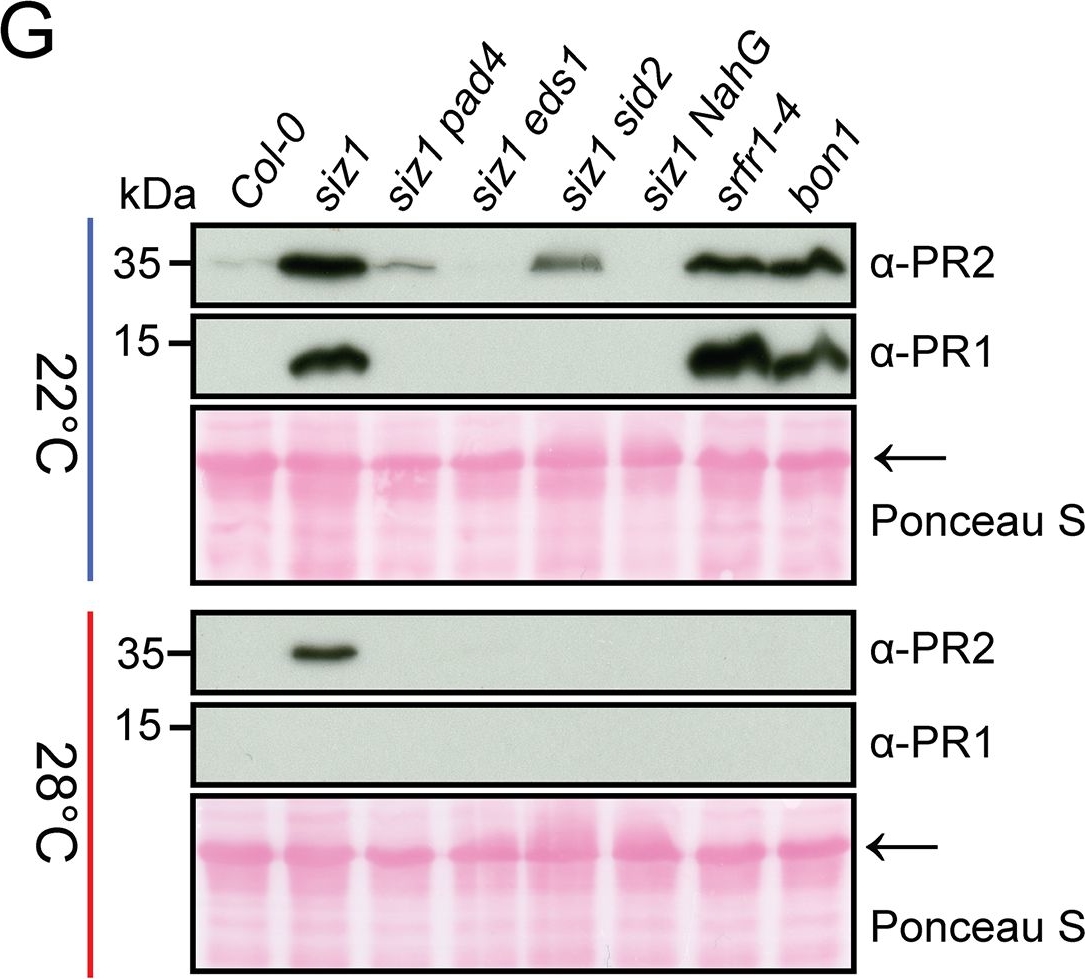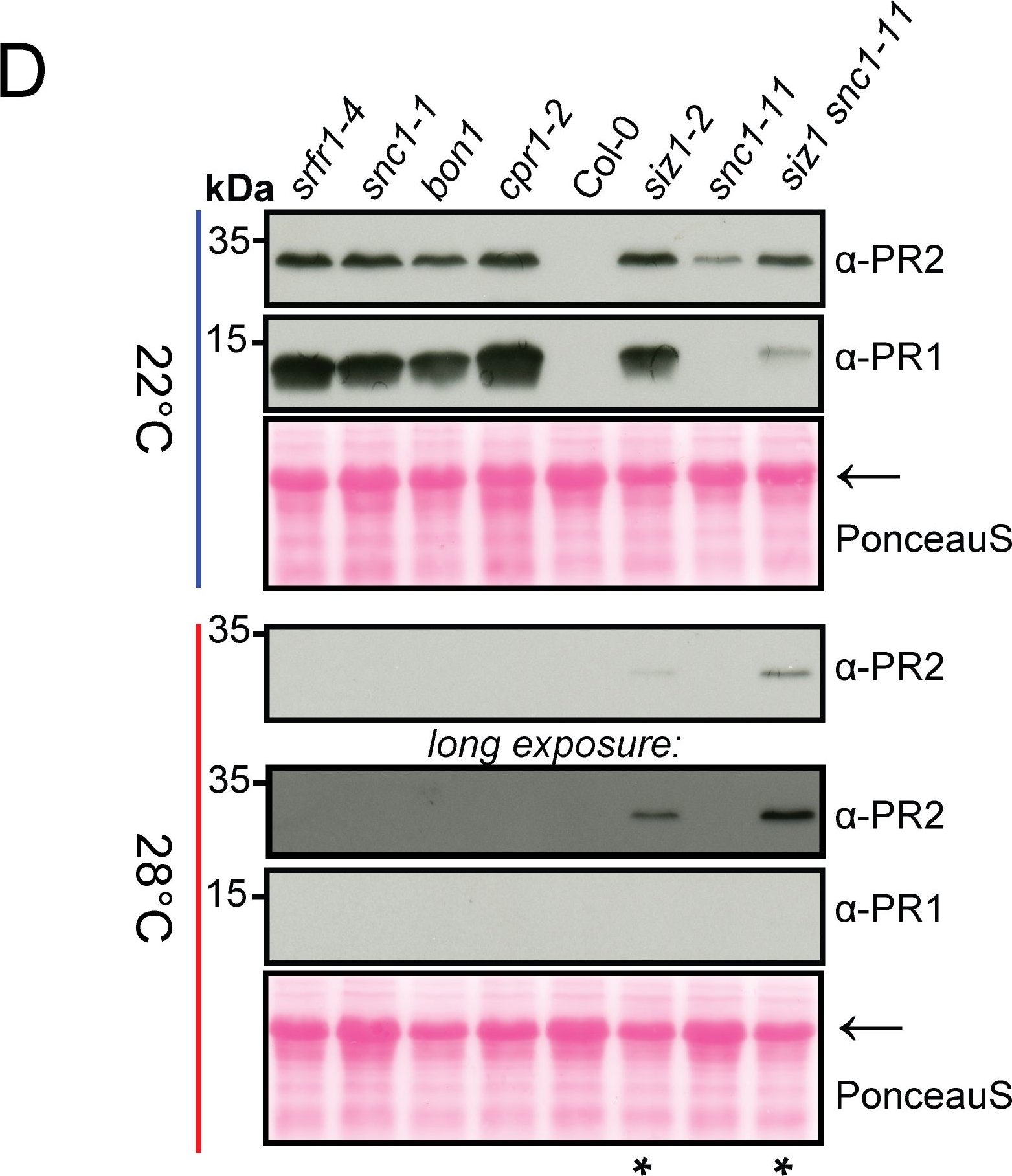1

Anti-PR-2 | Pathogenesis-related protein 2
AS12 2366 | Clonality: Polyclonal | Host: Rabbit | Reactivity: Arabidopsis thaliana, Agostis stolonifera cv. ‘Penncross’, Glycine max
- Data sheet
-
- Product Info
-
Immunogen: KLH-conjugated synthetic peptide derived from Arabidopsis thaliana PR-2 UniProt P33157, TAIR AT3G57260
Host: Rabbit Clonality: Polyclonal Purity: Serum Format: Lyophilized Quantity: 50 µl Reconstitution: For reconstitution add 50 µl of sterile water Storage: Store lyophilized/reconstituted at -20°C; once reconstituted make aliquots to avoid repeated freeze-thaw cycles. Please remember to spin the tubes briefly prior to opening them to avoid any losses that might occur from material adhering to the cap or sides of the tube. Tested applications: Western blot (WB) Recommended dilution: 1 : 1000 (WB) Expected | apparent MW: 37.3 kDa (processing aa 1-30, mature peptide 34.1 kD) - Reactivity
-
Confirmed reactivity: Agostis stolonifera cv. ‘Penncross’, Arabidopsis thaliana, Glycine max (roots) Predicted reactivity: Brassica juncea, Brassica oleracea, Citrus chinensis, Glycine max, Litchi chinensis, Manihot esculenta, Nicotiana tabacum
Species of your interest not listed? Contact usNot reactive in: No confirmed exceptions from predicted reactivity are currently known - Application Examples
-
Application example 
10 µg of total protein from Arabidopsis thaliana mature leaves were extracted with 8M UREA and were separated on 12 % SDS-PAGE and blotted 1h to PVDF. Blots were blocked with 5% Milk in TBS-T 0,05% for 1h at room temperature (RT) with agitation. Blot was incubated in the primary antibody at a dilution of 1: 1 000 for 1h at RT with agitation. The antibody solution was decanted and the blot was rinsed briefly twice, then washed once for 15 min and 3 times for 5 min in TBS-T at RT with agitation. Blot was incubated in secondary antibody (anti-rabbit IgG horse radish peroxidase conjugated, from Agrisera AS09 602) diluted to 1:10 000 in TBS-T/Milk 5% for 1h at RT with agitation. The blot was washed as above and developed for 5 min with ECL according to the manufacturers instructions. Exposure time was seconds 60 seconds.
Courtesy of Louis-Valentin Meteignier, PhD student, University of Sherbrooke, CanadaApplication examples: 
Reactant: Arabidopsis thaliana (Thale cress)
Application: Western Blotting
Pudmed ID: 29357355
Journal: PLoS Genet
Figure Number: 1G
Published Date: 2018-01-01
First Author: Hammoudi, V., Fokkens, L., et al.
Impact Factor: 5.334
Open PublicationWhile growth retardation of siz1 is hardly rescued at 28°C, other hallmarks of auto-immunity fully recover at this temperature.(A) Picture of the rosettes of siz1 and SNC1-dependent auto-immune mutants (crp1-2, bon1, snc1-1, srfr1-4) grown for 5 weeks in SD conditions at 22°C or 28°C. The mutants are in the Col-0 background. (B) Box-plot (middle bar = median, box limit = upper and lower quartile, extremes = Min and Max values) depicting the rosette weight of the genotypes shown in (A). Plants were 5-week-old plants. Significant differences were detected using a two-way ANOVA with Tukey’s multiple comparisons test: Genotype p-value<0.0001 (29% of the variation), Temperature p-value<0.001 (37%); GxT interaction p-value<0.0001 (22%); letters indicate significantly different post hoc groups (n = 8–10). The experiment was repeated 3 times with similar result. (C, D) Similar to (A), plants were grown in parallel for 5-weeks at 22°C or 28°C. The top row depicts wild type Col-0 and the single mutants, while the bottom row depicts siz1 and siz1 crossed with the mutants of the top row. (E) Box-plot with the rosette weight of the plants of panels (C, D). The statistical test was similar to (B) with similar result (n = 8). siz pad4-1, siz1 eds1-2, and siz1 NahG show a small recovery at 22°C (C) without any additional effect at 28°C (D). The experiment was repeated three times with similar result. Left side, single mutants; right side, siz1 and the corresponding double mutants. (F) Spontaneous cell death is absent in siz1 at 28°C, but also 22°C when EDS1/PAD4 are mutated or SA accumulation is compromised (NahG). Fully elongated leaves of 5-week-old plants were stained with Trypan blue and examined under the microscope. (G) Accumulation of PR1/PR2 in siz1 double mutants grown at 22°C or 28°C. srfr1 and bon1 are shown as control for PR accumulation. Total protein was extracted from 5-week-old plants. PR proteins were detected with polyclonal antibodies. Blots were stained with Ponceau S to confirm equal protein loading (? = Rubisco). The blots shown are a single exposure on one film of gels run/blotted in parallel with the samples taken in parallel as well. The apparent Mw of marker proteins is shown on the left.

Reactant: Arabidopsis thaliana (Thale cress)
Application: Western Blotting
Pudmed ID: 29357355
Journal: PLoS Genet
Figure Number: 2D
Published Date: 2018-01-01
First Author: Hammoudi, V., Fokkens, L., et al.
Impact Factor: 5.334
Open PublicationThe siz1 auto-immune phenotype is partially rescued by loss of SNC1.(A) Picture of the rosettes of siz1 and the siz1 snc1-11 double at 22°C/28°C. At 22°C growth retardation of siz1 is partially recovered in the snc1-11 background, while at 28°C siz1 snc1-11 does not show any additional recovery to siz1. Plants were 5-weeks-old (SD). (B) Box plot showing the rosette weight of the plants in (A). Significant differences were determined using a two-ay ANOVA followed by a Tukey post-hoc test: Genotype p-value<0.0001 (75% of the variation), Temperature p-value = 0.0033 (2.1%); GxT interaction p-value<0.0001 (8.8%). The letters indicate statistically different post hoc groups (n = 8) (C) Spontaneous cell death in siz1 requires SNC1 function. Fully elongated leaves of 5-week-old plants were stained with Trypan blue. (D) Accumulation of PR1 and PR2 is partially suppressed in siz1 snc1-11. As control for thermosensitive accumulation of PR proteins, srf1-4, snc1-1, bon1 and cpr1-2 are shown. Total protein was extracted from 5-week-old plants. The blots were prepared in parallel and ECL detection was done on one film, except for the ‘long exposure’ to reveal PR2 accumulation. Blots were stained with Ponceau S to confirm equal protein loading. Asterisks mark enhanced PR2 accumulation in siz1-2 and siz1 snc1-11 at 28°C. (E) Normalized gene expression of PR1, PR2 and SNC1 (mean ± SE) in 5-week-old plants (fold change; Col-0 at 22°C = 1). PR1 and PR2 expression are still elevated in siz1 snc1-11 at 22°C. At 28°C PR1 expression is gone in siz1 snc1-11, while PR2 expression remains up regulated (7-fold up).
- Additional Information
-
Additional information: This product can be sold containing Proclin if requested Additional information (application): Does not cross-react with other 1,3-beta glucosidases - Background
-
Background: PR-2 (Pathogenesis-related protein 2) is involved in the defence of plants against pathogens. This protein has a catalytic activity and is hydrolysing of (1->3)-beta-D-glucosidic linkages in (1->3)-beta-D-glucans, EC=3.2.1.39. Alternative names:Glucan endo-1,3-beta-glucosidase, acidic isoform, (1->3)-beta-glucan endohydrolase, Beta-1,3-endoglucanase, Beta-1,3-glucanase 2 - Product Citations
-
Selected references: Bernacki et al. (2024).METACASPASE8 (MC8) Is a Crucial Protein in the LSD1-Dependent Cell Death Pathway in Response to Ultraviolet Stress. Int. J. Mol. Sci. 2024, 25(6), 3195
Dong et al. (2020). Overexpression of BrAFP1 gene from winter rapeseed (Brassica rapa) confers cold tolerance in Arabidopsis. Plant Physiol Biochem. 2020 Jul 25;155:338-345.doi: 10.1016/j.plaphy.2020.07.011.
Lv et al. (2019). Uncoupled Expression of Nuclear and Plastid Photosynthesis-Associated Genes Contributes to Cell Death in a Lesion Mimic Mutant. Plant Cell. 2019 Jan;31(1):210-230. doi: 10.1105/tpc.18.00813.
Jespersen et al. (2017). Metabolic Effects of Acibenzolar-S-Methyl for Improving Heat or Drought Stress in Creeping Bentgrass. Front Plant Sci. 2017 Jul 11;8:1224. doi: 10.3389/fpls.2017.01224. eCollection 2017. (western blot, Agostis stolonifera cv. ?Penncross?)
Kim et al. (2014). The Arabidopsis Immune Adaptor SRFR1 Interacts with TCP Transcription Factors thatRedundantly Contribute to Effector-Triggered Immunity. Plant J. 2014 Apr 1. doi: 10.1111/tpj.12527. - Protocols
-
Agrisera Western Blot protocol and video tutorials
Protocols to work with plant and algal protein extracts
Oxygenic photosynthesis poster by prof. Govindjee and Dr. Shevela
Z-scheme of photosynthetic electron transport by prof. Govindjee and Dr. Björn and Dr. Shevela - Reviews:
-
This product doesn't have any reviews.



